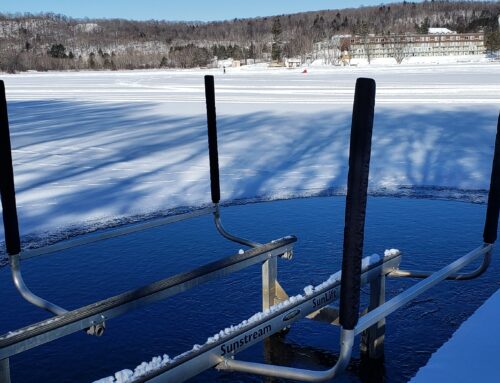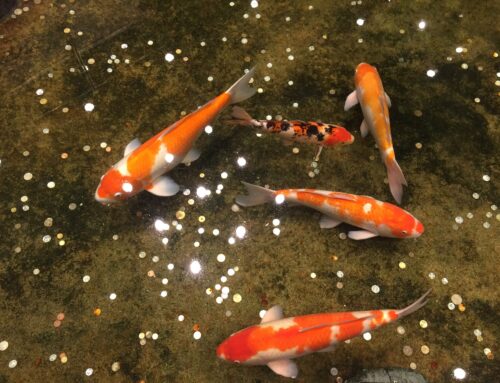What happens in your pond under the ice?
 Although the colours of winter move to a more monochrome palette during darker, shorter days, and it may look like life has ceased in and around the pond, this isn’t the case. Even if it is slowing down, the activity under the ice does not stop. Millions of bacteria are still attempting to reduce, transform and digest the large amounts of organic matter that most ponds accumulate especially after leaves have fallen around the pond and aquatic plants in it, have died. Although some of these bacteria can work anaerobically, (that is to say, without oxygen) most need oxygen to live and consume a significant amount of organic matter. This, is why the available oxygen in this self-contained aquatic environment, tends to decrease dramatically over the winter. The waste gases produced as part of the process of digestion, tend to accumulate under the ice, lowering the water quality.
Although the colours of winter move to a more monochrome palette during darker, shorter days, and it may look like life has ceased in and around the pond, this isn’t the case. Even if it is slowing down, the activity under the ice does not stop. Millions of bacteria are still attempting to reduce, transform and digest the large amounts of organic matter that most ponds accumulate especially after leaves have fallen around the pond and aquatic plants in it, have died. Although some of these bacteria can work anaerobically, (that is to say, without oxygen) most need oxygen to live and consume a significant amount of organic matter. This, is why the available oxygen in this self-contained aquatic environment, tends to decrease dramatically over the winter. The waste gases produced as part of the process of digestion, tend to accumulate under the ice, lowering the water quality.
As the ice thickens and the snow depth increases on the surface of a pond the most critical (or deadly) period for fish. Without ice coverage, gases can escape and some mixing takes place naturally, in the winter, however ice forms an insulating plug that prevents any transfer of gases either by adding oxygen from wind or releasing gases resulting from decomposition. The lack of light from shorter days, snow and ice coverage also stops photosynthesis in aquatic plants, further preventing oxygenation at a time of continued decomposition. Eventually the available O2 can be depleted, and or replaced with toxic gases like H2S which lead directly to fish kill, and tend to turn the pond into a murky, smelly unpleasant body of water that might be more reminiscent of a swamp than a picturesque pond.

Luckily for pond owners concerned about the health of their pond, there are a number of aeration systems on the market, that provide winter operating capabilities. Deiceair’s Canadian Air System and Small Aeration Systems (SAS) are the perfect fit for almost any size pond. If your pond is 5 foot deep or shallower, the SAS system (which is available with either single or multiple diffusers) is a high quality, entry-level aerator at a great price. Of course the best option for ponds, of almost any size, is the Canadian Air System, with its benchmark setting Bubble Tubing diffuser. The Canadian Aeration System offers the greatest efficiency and efficacy of any pond aerator on the market. Both of these system are Sub Surface or Bottom Up Aerators. This means the Diffusers (the business end of an aeration system) adds oxygen at the basin or bottom of a body of water, this allows 02 to be more evenly circulated to a much larger area than aerators. In the case of the Bubble Tubing based Canadian Aeration System, the amount of Dissolved Oxygen produced is demonstrably greater than other systems. With Millions of Micro-Bubbles produced in long curtains of slowly moving, tiny bubbles, over the entire length of Bubble Tubing diffuser the amount of surface area and resulting distribution of O2 to the pond is substantially greater than other designs that concentrate air around a clover-leaf or looped aerator while using similar compressors.

Remember that a Cold Water Bacterial treatment like Canada’s Number 1 Cold Water Bacterial Conditioner Bacterius Equinox is another great way to ensure your pond is at it’s peak over the winter months. Bacterius® EQUINOX rapidly colonizes in the muck and quickly prevents the proliferation of sulfate-reducing bacteria that are responsible for H2S that contributes to anoxic conditions. H2S is a toxic gas that causes unpleasant odours (rotten egg smell) and deterioration of bacterial biofilms. Your aeration system will triple the effectiveness of the Bacterial Conditioner further benefiting the pond and the organisms that call it home.
Of course depending upon the size of your pond and location of your aerator/s, skating and hockey may not be possible while the aeration system is operating.
Remember to use common sense when operating an aeration system in the winter. Open Water signs and or other precautions might be necessary depending upon
where your pond is located.






